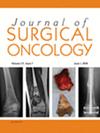胃神经内分泌肿瘤的分类及与生存期的关系
IF 2
3区 医学
Q3 ONCOLOGY
引用次数: 0
摘要
背景和目的并非所有的胃神经内分泌肿瘤(GNET)都能归类为已描述的三种临床病理亚型之一。本研究旨在更好地描述 GNET 亚型及相关预后。进一步审查了无法归类为 1、2 或 3 型的肿瘤病理标本。根据与使用质子泵抑制剂(PPI)相一致的背景胃黏膜变化,GNET被归类为与质子泵抑制剂(PPI)相关的肿瘤。结果 在246例患者中,1型GNET有164例(67%),2型有5例(2%),3型有52例(21%),PPI相关型GNET有18例(7%)。7例(3%)肿瘤仍未分类。与1型(1%)、2型(20%)或PPI相关肿瘤(11%,P< 0.001)相比,3型GNET中DM的发生率更高(38%)。1型肿瘤的十年DSS率为100%,3型肿瘤为53%(95%置信区间[CI],38%-75%),PPI相关肿瘤为80%(95% CI,58%-100%)(p < 0.001)。GNET亚型、种族和DM与DSS独立相关。在总体预后中还应考虑其他因素。本文章由计算机程序翻译,如有差异,请以英文原文为准。
Classification of Gastric Neuroendocrine Tumors and Associations With Survival
Background and ObjectivesNot all gastric neuroendocrine tumors (GNETs) may be classified into one of the three described clinicopathologic subtypes. The purpose of this study was to better characterize GNET subtypes and associated outcomes.MethodsPatients treated for GNET at our institution (1995−2021) were identified. Pathologic specimens of tumors that could not be classified as type 1, 2, or 3 were further reviewed. GNETs were categorized as proton pump inhibitor (PPI)‐associated based on changes in the background gastric mucosa consistent with PPI use. Distant metastasis at presentation (DM) and disease‐specific survival (DSS) were evaluated.ResultsAmong 246 patients, there were 164 (67%) type 1, 5 (2%) type 2, 52 (21%) type 3, and 18 (7%) PPI‐associated GNETs. Seven (3%) tumors remained unclassified. DM was more frequent with type 3 GNETs (38%) than type 1 (1%), type 2 (20%), or PPI‐associated tumors (11%, p < 0.001). Ten‐year DSS rates were 100% for type 1, 53% (95% confidence interval [CI], 38%−75%) for type 3, and 80% (95% CI, 58%−100%) for PPI‐associated tumors (p < 0.001). GNET subtype, race, and DM were independently associated with DSS.ConclusionsPPI‐associated tumors may represent a distinct GNET subtype with intermediate outcomes. Other factors should also be considered in overall prognosis.
求助全文
通过发布文献求助,成功后即可免费获取论文全文。
去求助
来源期刊
CiteScore
4.70
自引率
4.00%
发文量
367
审稿时长
2 months
期刊介绍:
The Journal of Surgical Oncology offers peer-reviewed, original papers in the field of surgical oncology and broadly related surgical sciences, including reports on experimental and laboratory studies. As an international journal, the editors encourage participation from leading surgeons around the world. The JSO is the representative journal for the World Federation of Surgical Oncology Societies. Publishing 16 issues in 2 volumes each year, the journal accepts Research Articles, in-depth Reviews of timely interest, Letters to the Editor, and invited Editorials. Guest Editors from the JSO Editorial Board oversee multiple special Seminars issues each year. These Seminars include multifaceted Reviews on a particular topic or current issue in surgical oncology, which are invited from experts in the field.

 求助内容:
求助内容: 应助结果提醒方式:
应助结果提醒方式:


